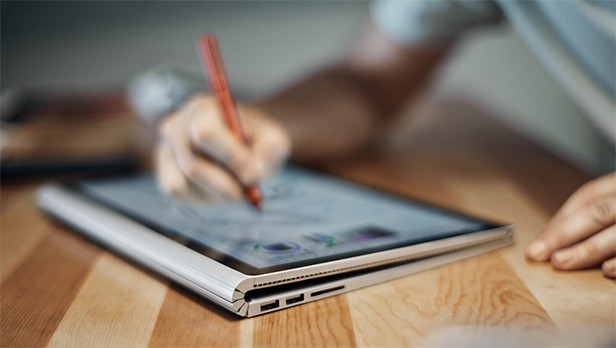Microsoft’s Surface Book created quite a stir when it was introduced during the company’s hardware event on October 6, 2015. The innovative Windows 10 2-in-1 sought to create the best combination of traditional notebook and Windows tablet and arguably succeeded. Certainly, the Surface Book has taken its place as one of the most well-respected high-end Windows 10 notebooks while putting in respectable double-duty as a digital clipboard.
The Surface Book incorporates a number of innovative features, including the “Dynamic Fulcrum” hinge, active latching mechanism, and switchable discrete GPU in the keyboard base. In many ways, Microsoft’s Design team did a tremendous amount of work in creating Microsoft’s most forward-thinking piece of hardware yet.
In a post on the Windows blog, the team provides a detailed accounting of the process of designing the Surface Book, from when the machine was first conceptualized to its release. The process took a full two years and required the company to overcome a number of design challenges.
Try to recall one of those first magical moments when you made something work: you built a baking soda volcano for the science fair, you rode your two-wheel bike down the driveway, you tinkered with the guts of a clock. Now imagine that the world was watching, waiting with bated breath for the result. Imagine you were backed by an incredible, diversified team. Imagine that your achievement – the solution you found – was a eureka moment born of true tenacity and toil.
This is how the Surface team felt every day for two years, as they embarked on the challenges of creating the Surface Book. Particularly, the unique folio hinge and detach mechanism required relentless brainstorming, doodling, building, testing, scrapping, head scratching, high-fiving, prototyping, and more prototyping. So much prototyping, in fact, that Industrial Designer Kait Schoeck laughs at the absurd amount of material the Surface team managed to create.

In speaking about stacking Surface Book prototypes from the floor to the ceiling, the designers highlight the challenge of creating something new with the objective of making it perfect. Ultimately, the team settled on one overriding concept, which was to envision the product in the form factor that was eventually incorporated into the product’s name: a book.
“You want to keep it as an object and not a gadget,” said Schoeck. “You want it to really distill down into what it should be.”
“The design team I think fell in love with the book metaphor,” said O’Neil. “So this idea of this object that folds in half…the icon was a lot of the early work, of what we wanted this product to feel like. And then the detachable part made it a super challenging product, to maintain that essence.”
The other major innovation incorporated into the muscle wire latching system, which needed to not only lock the keyboard section and clipboard together but also ensure the ability for the intelligence that resides in both halves to work together. The simple docking mechanism utilized in the Surface Pro machines, for example, wouldn’t likely suffice.

The incorporation of muscle wire into the design was the key design decision that made the product possible. And, the technology uses some pretty advanced material and design concepts.
Now, these were not completed, NASA-approved products. But they did function in a way that utilized all the best attributes of the material. Muscle wire (other names include nitinol wire and SMA, or shape-memory alloy) is a smart material that changes shape in response to external stimuli. For Surface Book, an electric current is applied, and it changes shape (or shrinks) to release the mechanical lever.
The entire blog post is fascinating in how it provides an in-depth look into the design and ultimate realization of such futuristic machines. One of the more astonishing aspects of the project that’s not specifically covered in the post is just how the team managed to keep the Surface Book a secret for so long. Arguably, Microsoft vastly exceeded even Apple’s secretive nature, because nobody had the slightest clue of what Microsoft was about to introduce last October.
Take a few minutes to read the entire piece; it’s worth it. In the meantime, we’re looking forward to Build 2016, where we’ll hopefully learn more details about how Microsoft intends to provide the software to maximize the amazing hardware that’s built into products like the Surface Book.


